I hate the cold. But the bonus of a deep-frozen day is the stunning dawn and dusk that is so frequent with such chill.
We walked out into the beauty of the January wolf-light. Because of the sun, despite the freezing air the land must have held some warmth, as a thin duvet of dusky mist was gliding up to sit a metre thick above the fields. We walked the dog on the ridge road above our house; the sky to the west was deep gold. The nearer trees in their nudity were dramatic against the skyline; then a band of deeper hazy blue, then the architecture of the far wooded hills with a clear-lined pocket of acrobatting turbines lifted above them.
Eastwards, above the milky layer, the sky was a pale slate-blue – what a French paint company would, indeed does, call ‘pluie d’été’: summer rain. Strata of peach, apricot, mirabelle-gold segued into blue innocence.
From the top of an oak tree a song thrush began fluting, and I felt, at last, as if I’d emerged through a break in the interminable internal cloud cover, taken a deep breath, stepped into the Otherworld.
Those swans
Hello, my friends. I’m so pleased to be back. I won’t relay the tedious practical, technological, mechanical and material hitches since just before Christmas; but it’s because of those that I’ve not been here this year, and also have been a bit sleepless. I’ll also skip the well-meaning but somewhat banal usual new year wishes. We’re all aware that a full life can’t avoid suffering and grief as well as joy and pleasure: what counts is how we navigate it. I wish you clear and gentle navigations of all that life offers you: remember you are more than your emotional reactions.
And we are not in Gaza.
The swans. If you’ve been with me for a while you will know that I’m preoccupied with the swans on the lake in our local town of Huelgoat: how they clearly migrate (supposedly there’s no mute swan population on the northern coasts of Brittany), and how I watched with concern the one solo swan this summer; was delighted when another pair came back in; was overjoyed when he or she was joined by a mate; was thrown into consternation when someone told me it was a goose; was thrilled when at least, just before Christmas, it seemed that all seven were back (two are off somewhere now, possibly nesting).
I’ve recently concluded that at least one and possibly more might be neither mute swan nor goose, but actually whooper or Bewick’s swan/s: more slender, less curvaceous and slightly smaller than the mutes, with a yellow and/or black beak instead of the orange-red one. I haven’t yet seen them close enough up to be sure, but no doubt I’ll write more about them at some stage.
Kiwi fruit
I didn’t know that kiwi thrives in Brittany until we visited some friends here, before moving over, one winter a few years ago. As we left in the late afternoon, our friend reached up and pulled two ripe kiwi fruit from the vine cascading through her fir tree.
And we found to our joy we had a massive vine here, on the south-facing front of the barn. Unfortunately, in a fit of tidy pruning of the grapevine, we managed to pull it up.
So it was with pleasure that TM, removing the tatty tarp and replacing it with cedar timbers at the back of said barn in late December, discovered that, enshrined in brambles on the north side, was a kiwi vine laden with fruit. We brought in well over a hundred fruits, some still ripening in the house. I have developed a simple but truly delicious kiwi cream sorbet for my vegan book: I will post the recipe here at some stage.
The potager
We are still eating largely from the kitchen garden. There are plenty of leeks, some Brussels sprouts, 3 varieties of kale (the perennial kale has leafed prolifically non-stop for over a year now), some rainbow chard, a little sorrel, plenty of herbs and, in the freezer, still many bags of our podded beans. We have a good crop of onions in store (yellow, red and the local Keravel pink), garlic, and some very decent-sized squashes. The purple sprouting broccoli, that delicious winter treat, has begun to flower at last. Our potatoes, sadly, succumbed to blight, though those we salvaged did us until last week.
And then there’s the quinoa
Great crop. So easy to grow. Pretty. Nice discovery, as I was so snotty about quinoa back in the UK. I thought of it as a pretentious middle-class affectation (what’s wrong with European brown rice??), completely unsustainable: flown in from Peru (food miles! Unseasonal!) where it is grown as a cash crop for export by families living in poverty, who could better use the land for their own food crops (unethical!). A Yummy-Mummy food. Keeennnwhahhh.
Then I discovered that it was a) being grown in the UK (Hodmedods of East Anglia); b) extremely high in protein (five times more than rice); and c) more environmentally-friendly than rice in the growing. So obviously we tried it here – wonderful vegan protein.
It’s a relative of fat hen, chenopodium album, which grows on wasteland and is seen as a weed, though I have always eaten the leaves (cooked like spinach).
As you can see, it’s a good-looking grain, and grew very well here, without any attention. I cut and dried 100s of stems in large paper sacks in the utility room.
The pictures above show you the process. We (well, I) spread out a large sheet on the kitchen table. The weather was not good enough to thresh and winnow it outside, where you are supposed to be able to whack it against a firm surface, then pour the resulting grains from one large bowl to another large bowl about half a metre below, when a light breeze will separate the grain from the chaff.
Haha.
I rubbed the heads between my hands, and extremely gently, very-small-handful by very-small-handful, carefully blew the chaff away. (Strangely, at this point, TM disappeared.) After an hour, and about 8 stalks, I had the amount shown above in the bowl for my efforts.
We cooked it the next day – just enough to accompany a veg dish. The saponin coating of quinoa is bitter. I first rinsed it and rinsed it, averting my mind from one of the cookbooks that said I’d probably need to also simmer it and rinse it again (and again) before properly cooking it.
We had a small portion each. It was bitter and chaffy. I’m sorry to say that this magnificent grain is still hanging in its paper sacks in the utility room.
If any of you reading this has a small old hand-operated winnowing machine, or a technique known from experience only (I’ve read all the theory), I will happily cross both your palms with this magical proteinous grain. And again.
~~~
Thanks, my friends, for reading this. And I’m pleased to be with you again. And of course I’d love it if you liked, shared, and/or commented on this post. More soon!





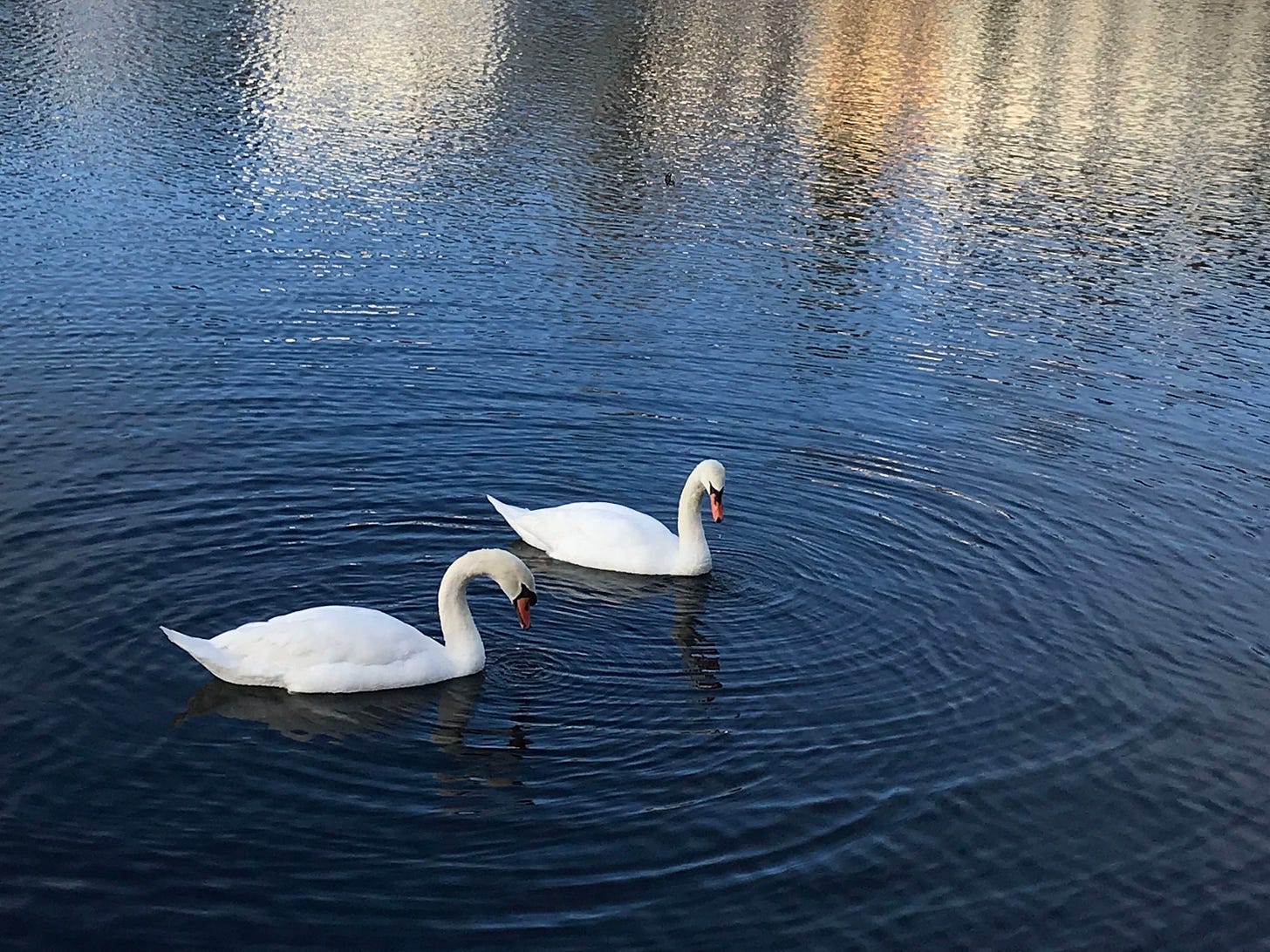
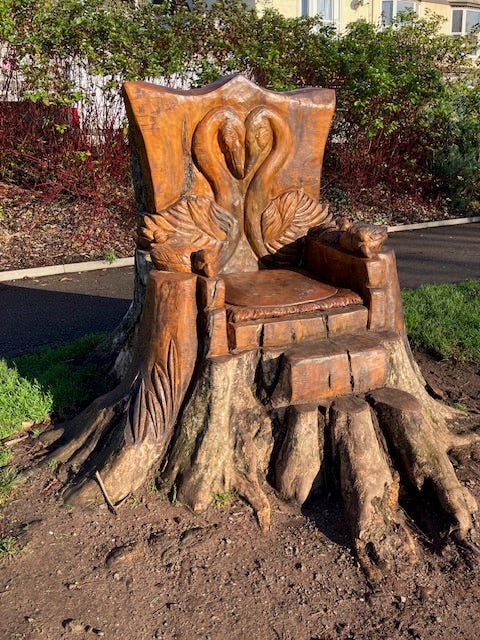
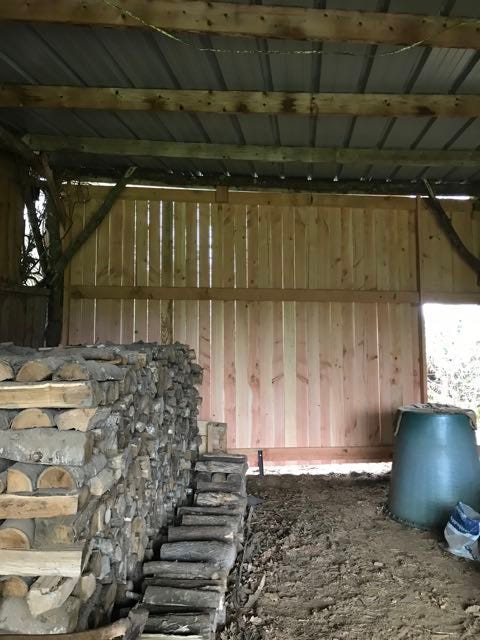
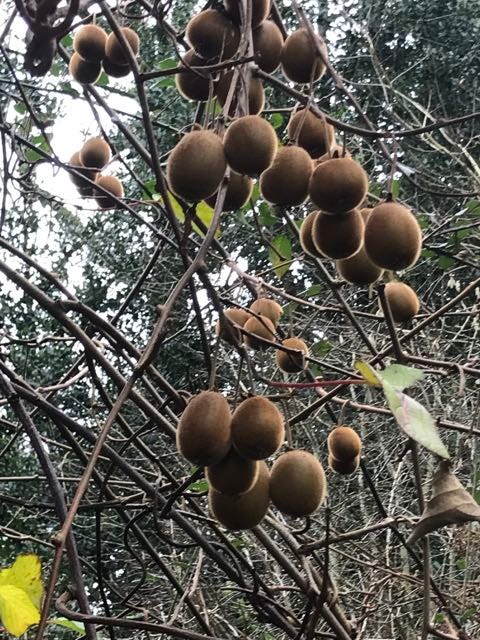
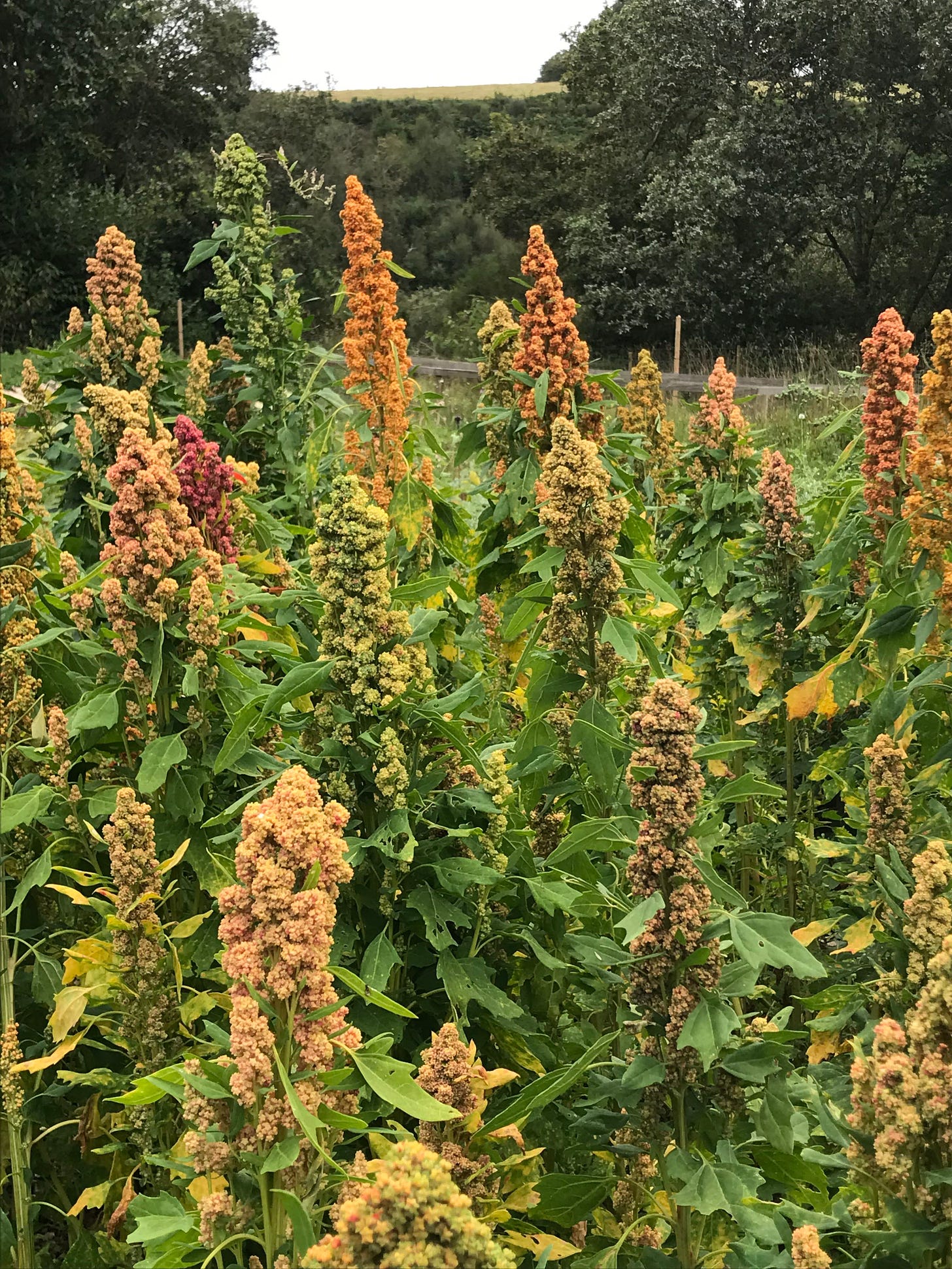
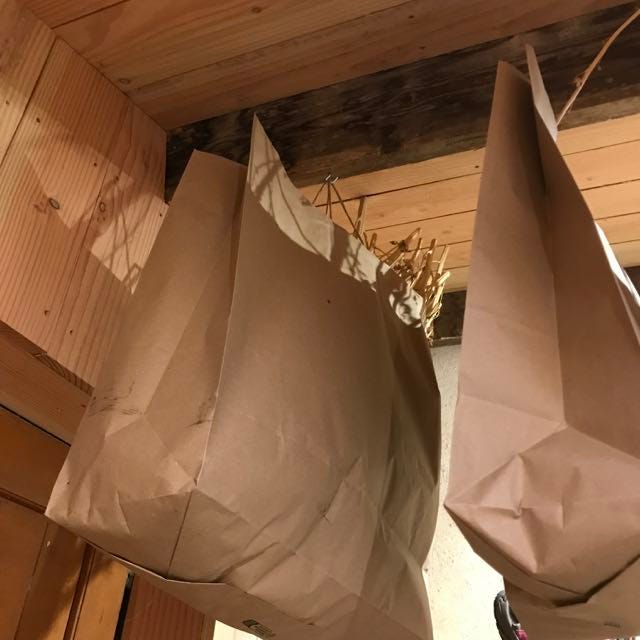

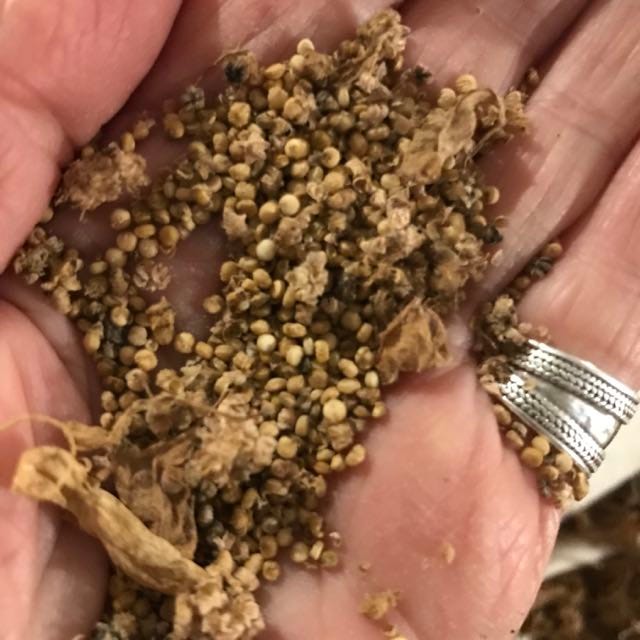
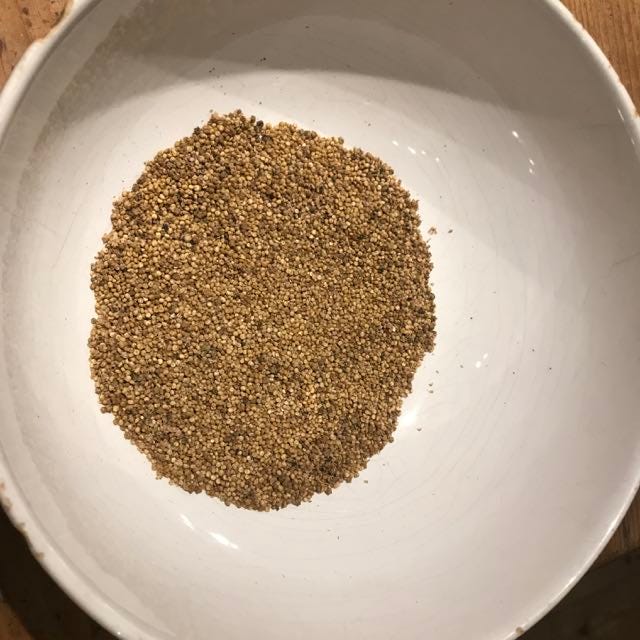
I've been itching to grow quinoa. I'll definitely keep your experience in mind when I experiment with it.
Interesting to find quinoa here in my cross-Substack explorations. I grow about 25-30 lbs of quinoa per year at a home scale, after growing 1000+ lbs per year at a seed company scale, and I have a little document with cleaning tips. Feet on a tarp (to thresh), a fan (to winnow), a shop vac (to de-husk), and a washing machine (to de-saponin) work wonders.
https://luterra.com/wp-content/uploads/2025/02/Quinoa.pdf
I have also designed a winnowing machine though it's a bit above a home scale and I don't currently ship overseas, but quinoa is pretty easy to winnow once you get the husks off the seeds with the shop vac. (Remaining husks will come off in the pillowcase-in-washing-machine step.)